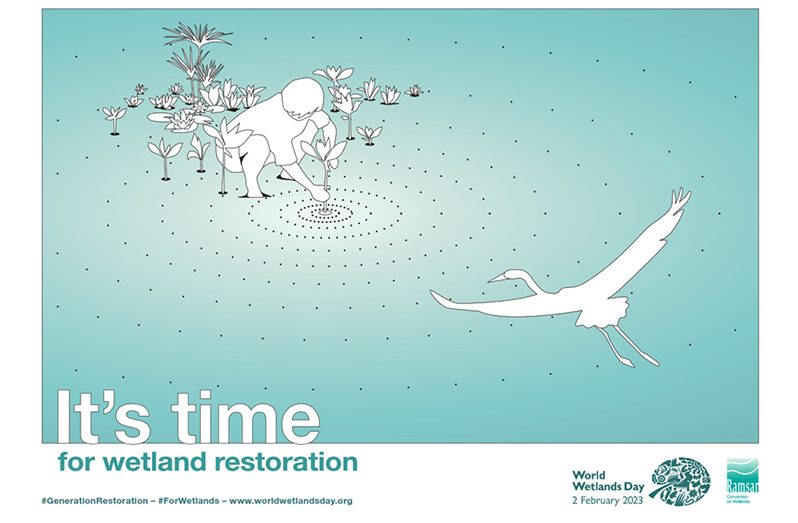ON February 2nd, 2023, Guyana and the world at large will come together to celebrate World Wetlands Day.
Wetlands are very important and dynamic ecosystems. They support unique plants and animals which interact with each other and the wetland environment to obtain the things they need to survive. As conditions change, the wetland as a unit change and so do the types of animals and plants they support.
Wetlands may be fresh, brackish or salty and can vary from large lakes to ponds, swamps, peatlands and bogs, slow streams, lagoons and estuaries. They also include ditches, water races, mining pits and hydro lakes.
The theme for the 2023 edition is “Wetland Restoration” which highlights the urgent need to prioritie wetland restoration in the world as we are losing our wetland resources faster than we are our forest.
What value wetlands bring?
Wetlands provide benefits for people and society as well as services for the environment.
Wetlands are critically important ecosystems that contribute to biodiversity, climate mitigation and adaptation, freshwater availability, global economies and livelihoods. With the functions of wetlands having many diverse layers, there is a seeming lack of community education and awareness on the values of wetlands.
The value of a wetland and the services it provides depends on a complex set of relationships between the wetland and the other ecosystems in the watershed. A watershed is an area such as a river basin, estuary lake or underground aquifer where water drains from higher elevations.
Wetlands significantly benefit society as they create recreation and tourism opportunities, and hence jobs. They also provide food for people and a place for them to practise some cultural traditions. Wetlands also provide transport and research services.
Wetlands provide several ecological services. They serve as nurseries for freshwater and marine fish and store and purify water. Wetlands also replenish groundwater and store carbon. They retain nutrients and sediments and also support a wide range of animals and plants (biodiversity). Because water drains into wetlands, they play an important role in flood control.
Wetlands support biodiversity
Wetlands are home to many rare and endangered animals and birds and provide secure nesting, brood-rearing, and safe feeding areas. It is one of the most productive ecosystems found in the world, particularly when compared to ecosystems such as rain forests. They support numerous species from all of the major groups of organisms – from microbes to mammals.
Wetlands provide home for many bird species; migrating birds seek refuge in Wetlands.
Wetlands provide great volumes of food that attract many animal species. These animals also use Wetlands for part of or all of their life cycle.
Wetlands in Guyana!
The North Rupununi Wetlands system is one of the largest wetlands in Guyana, the 54363 acres of land is dominated by the Rupununi, Rewa, and Essequibo Rivers, and include water bodies such as lakes, ponds and inlets.
Over 400 species of fish have been recorded in the area, leading to estimates of up to 600 species for the larger wetland system. The wetlands are also home to Guyana’s endangered giants, the Arapaima, Giant River Turtle, Black Caiman, and Giant River Otter.
Additionally, fish represents a major source of proteins in local communities within the region, while other wildlife species which depend on the wetlands for survival are used for commercial and daily subsistence.
The North Rupununi wetlands are also known for their rich indigenous culture and folklore and have significant aesthetic value, serving as a primary place of recreation for local residents. The rivers and waterways act as main transportation routes and serve as a source of drinking water. Water-loving palms and other vegetation are used for housing, craft making, traditional medicine and food for community members.
Guyana’s Low Carbon Development Strategy references wetlands, noting their importance to Guyana’s sustainable development thrust, and makes provision for the expansion of protected areas including wetlands.
Let us continue to protect our wetlands!
This World Wetlands Day, it is important for us to recognise that wetlands can be “restored” where they are degraded, and are not wastelands. Let’s start by doing our part diligently to avoid further damage or to even reverse some of the damage caused to Wetlands.
Here are some simple things you can do to help sustain our wetlands:
> Dispose of your waste properly;
> Reduce the use of fertilizers, pesticides and harmful chemicals;
> Do not use endangered or threatened species as food or souvenirs;
> Support and encourage conservation efforts – both national and in your community;
> Do not move wild plants or animals from one location to another; and
> Lobby for wetland protection policies.
You can share your ideas and questions by sending letters to: “Our Earth, Our Environment”, C/O Communications Department, Environmental Protection Agency, Ganges Street, Sophia, GEORGETOWN, or email us at: eit.epaguyana@gmail.com. Follow us on Facebook and Instagram and subscribe to our YouTube channel.


.jpg)











